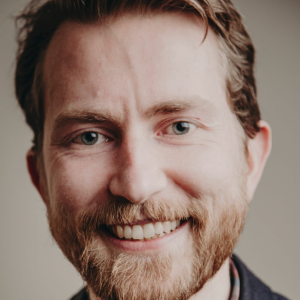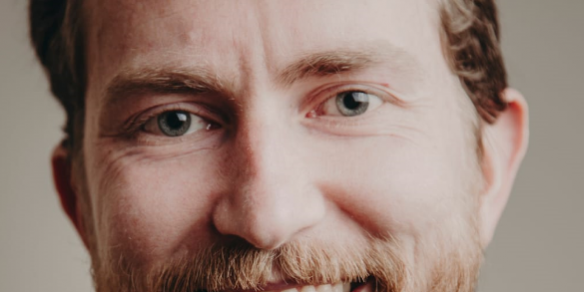Stryker Australia
One-on-one with David Hill
PhD student at RMIT University

David Hill
Knowing that his PhD research helps shape the operating theatre of the future, gives David Hill immense satisfaction. He speaks to IMCRC about his ‘small’ contribution to creating tailored just in time implants.
Q: What is your background, and what led you to take up a PhD position for this project?
I initially did an apprenticeship in aircraft maintenance. Unfortunately, the airline industry suffered a massive employment downturn at that time. So, I decided to re-skill and enrolled in a Biomedical Engineering course at RMIT University. I enjoyed the degree, where the focus was not just on human anatomy, but also electronics and biomechanics. During my last year, I participated in a larger project with the Bionics Institute. We were asked to evaluate and modify Cochlear hearing implants to predict when an epileptic episode was likely to happen. The project generated quite a bit of interest with the media which caught the attention of Prof. Milan Brandt, Director of RMIT’s Centre of Additive Manufacturing. He offered me a PhD position in the “Just-In-Time Implants” project which seemed too good of an opportunity to pass up.
Q: Tell me a bit about the project, and what is your role in it?
The “Just-In-Time Implants” project is a research collaboration between RMIT University, University of Technology Sydney (UTS), University of Sydney, University of Melbourne, St Vincent’s Hospital in Melbourne and global medical technology company Stryker.
It consists of two main parts: part one involves UTS evaluating and mapping the patient journey and regulatory pathway, while the second part focuses on the treatment of bone tumours, which involves research to transform the design and delivery of patient-specific implants. This part of the project combines research in medical imaging analysis, automated tumour segmentation, and the design and additive manufacture of implants.
As all research areas in the treatment of bone tumours are closely inter-linked, it’s been interesting to see how the results of my research are applied to tumour segmentation and implant design.
My role in the “Just-In-Time Implants” project is to create elaborate toolpaths for a surgical robot. By fitting complex shapes to 3D scans of bone tumours, I develop the cutting tools required to remove that shape whilst trying to minimise the amount of healthy bone removed in a tumour surgery. My work fits into the larger research collective, as it ties in closely with the work performed at St Vincent’s Hospital in tumour segmentation through medical imaging analysis, and the reconstruction of a complicated implant using additive manufacturing at RMIT. Seeing each small individual contribution gradually lead into something bigger has been satisfying. Especially, when things do work, but even when things go wrong, I still love the research work.
Q: What do you like most about the research and your PhD?
As medical technology evolves, it’s cool to think that my current research could significantly improve the outcome of tumour surgery in upcoming years, and thus benefit real people.
Working in a large team can be difficult, but also very enjoyable. As the imaging, robotic and implant team work very closely together, we constantly have to adjust the way we think about and approach our research, as the decision one team makes will affect the other two.
It’s been a huge learning curve. Many aspects of my initial biomedical engineering degree have been proven useful, for example, programming, physiology, and anatomy. However, there has also been a lot of on the job training. I had to learn about robotics as I didn’t know anything about robots when I started. Also, keeping in mind that I’m working with bone, which is a living material.
Q: How do you feel about an industry-led research project?
As my PhD is industry-focused, I understand that my research in one way or another will help the industry partner to achieve their objectives. Stryker is leading the “Just in Time Implants” project and it is very satisfying for me to say that I’ve made a small contribution to their project, knowing that my work may have some impact in the operating theatre in the future.
If I developed anything in a purely academic PhD, it might have sat on the shelf for years, even if I thought it was a very useful application. However, by working with an industry partner, you receive constructive feedback about your work. They will make suggestions and offer you directions if something needs to be considered or changed based on their knowledge and expertise. They won’t change my research as such but will provide valuable insights and a different outlook on the research. Stryker has been good in encouraging ideas, and it has been great to have an outlet to come up with the crazy ideas, and having an industry partner that supports my research, and potentially allowing it to go to a larger scale in the future.
Q: What do you see yourself doing after completing the PhD?
I think the research work I’m currently doing will not be completed at the end of my PhD. There will still be a lot more research required to refine the model. Thus, I would probably consider doing a post-doc at RMIT University and continue the work that I’m currently doing, or maybe, I work for Stryker to test what I’ve done.
Another path could be to work for a robotics company to improve robotic toolpaths. I like working in a collaborative environment, ideally in a company that operates in a space similar to the project, where I could apply the knowledge and skills that I’ve developed during this PhD.
I would prefer a role that is very hands-on as I enjoy working around the field of improving robotic surgery, whether it’s for bone tumours, hips or knees, etc.
